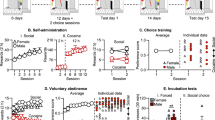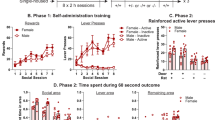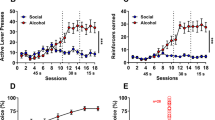Abstract
It is difficult to translate results from animal research on addiction to an understanding of the behavior of human drug users. Despite decades of basic research on neurobiological mechanisms of drug addiction, treatment options remain largely unchanged. A potential reason for this is that mechanistic studies using rodent models do not incorporate a critical facet of human addiction: volitional choices between drug use and non-drug social rewards (e.g., employment and family). Recently, we developed an operant model in which rats press a lever for rewarding social interaction with a peer and then choose between an addictive drug (heroin or methamphetamine) and social interaction. Using this model, we showed that rewarding social interaction suppresses drug self-administration, relapse to drug seeking, and brain responses to drug-associated cues. Here, we describe a protocol for operant social interaction using a discrete-trial choice between drugs and social interaction that causes voluntary abstinence from the drug and tests for incubation of drug craving (the time-dependent increase in drug seeking during abstinence). This protocol is flexible but generally requires 8–9 weeks for completion. We also provide a detailed description of the technical requirements and procedures for building the social self-administration and choice apparatus. Our protocol provides a reliable way to study the role of operant social reward in addiction and addiction vulnerability in the context of choices. We propose that this protocol can be used to study brain mechanisms of operant social reward and potentially impairments in social reward in animal models of psychiatric disorders and pain.
This is a preview of subscription content, access via your institution
Access options
Access Nature and 54 other Nature Portfolio journals
Get Nature+, our best-value online-access subscription
$29.99 / 30 days
cancel any time
Subscribe to this journal
Receive 12 print issues and online access
$259.00 per year
only $21.58 per issue
Buy this article
- Purchase on Springer Link
- Instant access to full article PDF
Prices may be subject to local taxes which are calculated during checkout







Similar content being viewed by others
Data and code availability
The Med-Associated programs are available from the corresponding authors (M.V. and Y.S.) upon request.
References
Dong, Y., Taylor, J. R., Wolf, M. E. & Shaham, Y. Circuit and synaptic plasticity mechanisms of drug relapse. J. Neurosci. 37, 10867–10876 (2017).
Jonkman, S. & Kenny, P. J. Molecular, cellular, and structural mechanisms of cocaine addiction: a key role for microRNAs. Neuropsychopharmacology 38, 198–211 (2013).
Nestler, E. J. Epigenetic mechanisms of drug addiction. Neuropharmacology 76(Pt B), 259–268 (2014).
de Wit, H., Epstein, D. H. & Preston, K. L. Does human language limit translatability of clinical and preclinical addiction research? Neuropsychopharmacology 43, 1985–1988 (2018).
Heilig, M., Epstein, D. H., Nader, M. A. & Shaham, Y. Time to connect: bringing social context into addiction neuroscience. Nat. Rev. Neurosci. 17, 592–599 (2016).
Aklin, W. M. et al. A therapeutic workplace for the long-term treatment of drug addiction and unemployment: eight-year outcomes of a social business intervention. J. Subst. Abus. Treat. 47, 329–338 (2014).
Venniro, M. et al. Volitional social interaction prevents drug addiction in rat models. Nat. Neurosci. 21, 1520–1529 (2018).
Azrin, N. H. et al. Follow-up results of supportive versus behavioral therapy for illicit drug use. Behav. Res. Ther. 34, 41–46 (1996).
Hunt, G. M. & Azrin, N. H. A community-reinforcement approach to alcoholism. Behav. Res. Ther. 11, 91–104 (1973).
Lash, S. J., Burden, J. L., Monteleone, B. R. & Lehmann, L. P. Social reinforcement of substance abuse treatment aftercare participation: impact on outcome. Addict. Behav. 29, 337–342 (2004).
Roozen, H. G. et al. A systematic review of the effectiveness of the community reinforcement approach in alcohol, cocaine and opioid addiction. Drug Alcohol Depend. 74, 1–13 (2004).
Stitzer, M. L., Jones, H. E., Tuten, M. & Wong, C. Community reinforcement approach and contingency management interventions for substance abuse in Handbook of Motivational Counseling: Goal-Based Approaches to Assessment and Intervention with Addiction and Other Problems (eds Cox, W. M. & Klinger, E.), Ch. 23 (Wiley, Chichester, 2011).
Banks, M. L. & Negus, S. S. Insights from preclinical choice models on treating drug addiction. Trends Pharmacol. Sci. 38, 181–194 (2017).
Nader, M. A. & Woolverton, W. L. Cocaine vs. food choice in rhesus monkeys: effects of increasing the response cost for cocaine. NIDA Res. Monogr. 105, 621 (1990).
Ahmed, S. H. Trying to make sense of rodents’ drug choice behavior. Prog. Neuropsychopharmacol. Biol. Psychiatry 87, 3–10 (2018).
Lenoir, M., Serre, F., Cantin, L. & Ahmed, S. H. Intense sweetness surpasses cocaine reward. PLoS One 2, e698 (2007).
Spragg, S. D. S. Morphine addiction in chimpanzees. Comp. Psychol. Mono. 15, 132 (1940).
Venniro, M., Caprioli, D. & Shaham, Y. Novel models of drug relapse and craving after voluntary abstinence. Neuropsychopharmacology 44, 234–235 (2019).
Caprioli, D. et al. Effect of the novel positive allosteric modulator of metabotropic glutamate receptor 2 AZD8529 on incubation of methamphetamine craving after prolonged voluntary abstinence in a rat model. Biol. Psychiatry 78, 463–473 (2015).
Caprioli, D. et al. Role of dorsomedial striatum neuronal ensembles in incubation of methamphetamine craving after voluntary abstinence. J. Neurosci. 37, 1014–1027 (2017).
Venniro, M. et al. The anterior insular cortex→central amygdala glutamatergic pathway is critical to relapse after contingency management. Neuron 96, 414–427.e8 (2017).
Venniro, M., Zhang, M., Shaham, Y. & Caprioli, D. Incubation of methamphetamine but not heroin craving after voluntary abstinence in male and female rats. Neuropsychopharmacology 42, 1126–1135 (2017).
Zimmer, B. A., Oleson, E. B. & Roberts, D. C. The motivation to self-administer is increased after a history of spiking brain levels of cocaine. Neuropsychopharmacology 37, 1901–1910 (2012).
Ahmed, S. H. & Koob, G. F. Transition from moderate to excessive drug intake: change in hedonic set point. Science 282, 298–300 (1998).
Deroche-Gamonet, V., Belin, D. & Piazza, P. V. Evidence for addiction-like behavior in the rat. Science 305, 1014–1017 (2004).
Venniro, M., Caprioli, D. & Shaham, Y. Animal models of drug relapse and craving: from drug priming-induced reinstatement to incubation of craving after voluntary abstinence. Prog. Brain Res. 224, 25–52 (2016).
Venniro, M., Russell, T. I., Zhang, M. & Shaham, Y. Operant social reward decreases incubation of heroin craving in male and female rats. Biol. Psychiatry 86, 848–856 (2019).
Grimm, J., Hope, B., Wise, R. & Shaham, Y. Neuroadaptation. Incubation of cocaine craving after withdrawal. Nature 412, 141–142 (2001).
Shalev, U., Grimm, J. & Shaham, Y. Neurobiology of relapse to heroin and cocaine seeking: a review. Pharmacol. Rev. 54, 1–42 (2002).
Vanderschuren, L. J., Achterberg, E. J. & Trezza, V. The neurobiology of social play and its rewarding value in rats. Neurosci. Biobehav. Rev. 70, 86–105 (2016).
Bardo, M. T., Neisewander, J. L. & Kelly, T. H. Individual differences and social influences on the neurobehavioral pharmacology of abused drugs. Pharmacol. Rev. 65, 255–290 (2013).
Smith, M. A. Peer influences on drug self-administration: social facilitation and social inhibition of cocaine intake in male rats. Psychopharmacol. (Berl.) 224, 81–90 (2012).
Solinas, M., Chauvet, C., Thiriet, N., El Rawas, R. & Jaber, M. Reversal of cocaine addiction by environmental enrichment. Proc. Natl Acad. Sci. USA 105, 17145–17150 (2008).
Zlebnik, N. E. & Carroll, M. E. Prevention of the incubation of cocaine seeking by aerobic exercise in female rats. Psychopharmacol. (Berl.) 232, 3507–3513 (2015).
Fritz, M. et al. Reversal of cocaine-conditioned place preference and mesocorticolimbic Zif268 expression by social interaction in rats. Addict. Biol. 16, 273–284 (2011).
Zernig, G., Kummer, K. K. & Prast, J. M. Dyadic social interaction as an alternative reward to cocaine. Front. Psychiatry 4, 100 (2013).
Peitz, G. W. et al. Peer influences on drug self-administration: an econometric analysis in socially housed rats. Behav. Pharmacol. 24, 114–123 (2013).
Smith, M. A. & Pitts, E. G. Social preference and drug self-administration: a preclinical model of social choice within peer groups. Drug Alcohol Depend. 135, 140–145 (2014).
Smith, M. A., Strickland, J. C., Bills, S. E. & Lacy, R. T. The effects of a shared history of drug exposure on social choice. Behav. Pharmacol. 26, 631–635 (2015).
Strickland, J. C. & Smith, M. A. Animal models of social contact and drug self-administration. Pharmacol. Biochem. Behav. 136, 47–54 (2015).
Azrin, N. H. Improvements in the community-reinforcement approach to alcoholism. Behav. Res. Ther. 14, 339–348 (1976).
Silverman, K., DeFulio, A. & Sigurdsson, S. O. Maintenance of reinforcement to address the chronic nature of drug addiction. Prev. Med. 55(Suppl.), S46–S53 (2012).
Heyman, G. M. Addiction and choice: theory and new data. Front. Psychiatry 4, 31 (2013).
Monterosso, J. & Ainslie, G. The behavioral economics of will in recovery from addiction. Drug Alcohol Depend. 90(Suppl. 1), S100–S111 (2007).
Stitzer, M. & Petry, N. Contingency management for treatment of substance abuse. Annu. Rev. Clin. Psychol. 2, 411–434 (2006).
Richardson, N. R. & Roberts, D. C. Progressive ratio schedules in drug self-administration studies in rats: a method to evaluate reinforcing efficacy. J. Neurosci. Methods 66, 1–11 (1996).
Acknowledgements
We thank T.I. Russell for her help during the experiments and D. Harvey for proofreading and editorial comments on the original version of the manuscript. The research was supported by the Intramural Research Program of NIDA, a fellowship from the NIH Center on Compulsive Behaviors (M.V.), and a NARSAD Distinguished Investigator Grant Award (Y.S.).
Author information
Authors and Affiliations
Contributions
M.V. and Y.S. designed the experiments; M.V. ran the experiments and collected the data; M.V. and Y.S. analyzed the data; M.V. and Y.S. wrote the paper.
Corresponding authors
Ethics declarations
Competing interests
The authors declare no competing interests.
Additional information
Peer review information Nature Protocols thanks Francesco Papaleo and the other, anonymous, reviewer(s) for their contribution to the peer review of this work.
Publisher’s note Springer Nature remains neutral with regard to jurisdictional claims in published maps and institutional affiliations.
Related links
Key references using this protocol
Venniro, M. et al. Nat. Neurosci. 21, 1520–1529 (2018): https://doi.org/10.1038/s41593-018-0246-6
Venniro, M., Russell, T. I., Zhang, M. & Shaham, Y. Biol. Psychiatry 86, 848–856. (2019): https://doi.org/10.1016/j.biopsych.2019.05.018
Supplementary information
Rights and permissions
Springer Nature or its licensor (e.g. a society or other partner) holds exclusive rights to this article under a publishing agreement with the author(s) or other rightsholder(s); author self-archiving of the accepted manuscript version of this article is solely governed by the terms of such publishing agreement and applicable law.
About this article
Cite this article
Venniro, M., Shaham, Y. An operant social self-administration and choice model in rats. Nat Protoc 15, 1542–1559 (2020). https://doi.org/10.1038/s41596-020-0296-6
Received:
Accepted:
Published:
Issue Date:
DOI: https://doi.org/10.1038/s41596-020-0296-6
This article is cited by
-
Social odor choice buffers drug craving
Neuropsychopharmacology (2024)
-
Operant social self-administration in male CD1 mice
Psychopharmacology (2024)
-
An operant social self-administration and choice model in mice
Nature Protocols (2023)
-
The human neuropsychiatric risk gene Drd2 is necessary for social functioning across evolutionary distant species
Molecular Psychiatry (2023)
-
Preventing incubation of drug craving to treat drug relapse: from bench to bedside
Molecular Psychiatry (2023)
Comments
By submitting a comment you agree to abide by our Terms and Community Guidelines. If you find something abusive or that does not comply with our terms or guidelines please flag it as inappropriate.



